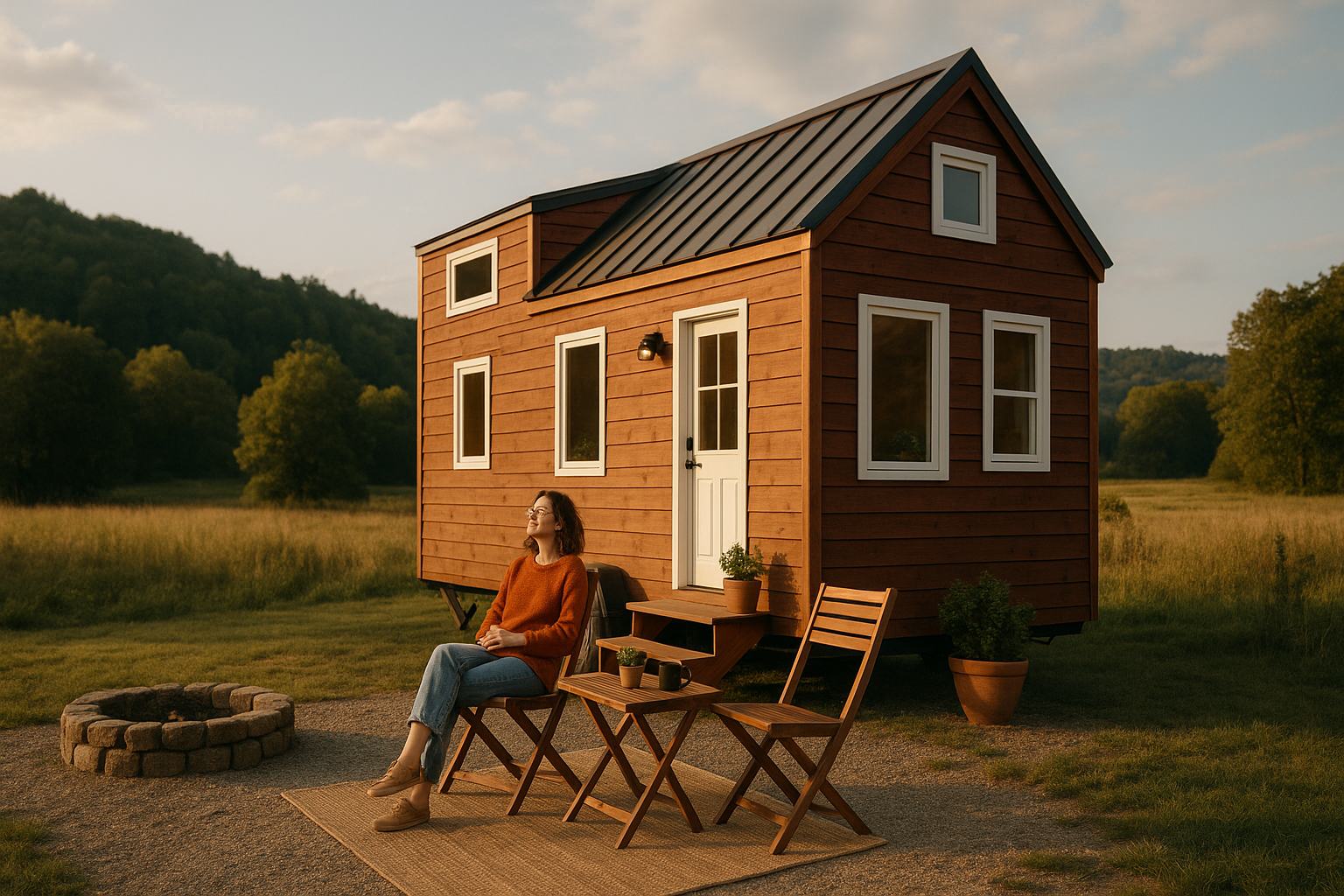
Estimated reading time: 10 minutes
Key Takeaways
- Tiny home living offers financial benefits by reducing costs and maintenance.
- Environmental sustainability is enhanced thanks to lower resource usage and carbon footprints.
- The minimalist lifestyle promotes intentional living and a focus on experiences over possessions.
- Innovative design and multipurpose spaces are key to making every square foot count.
- While challenges such as space limits and zoning exist, practical tips and planning can overcome them.
Table of contents
- Introduction: Tiny Home Living and Its Growing Popularity
- What Is Tiny Living?
- Benefits of Tiny House Living
- The Appeal of Minimalist Tiny Houses
- Challenges of Tiny Living and How to Overcome Them
- Practical Tips to Start Your Tiny Living Journey
- Conclusion: Why Tiny Home Living Is a Smart Lifestyle Choice
- Frequently Asked Questions
Introduction: Tiny Home Living and Its Growing Popularity
Tiny home living is a lifestyle choice that’s capturing the imagination of people everywhere. In the past decade, more individuals and families have begun embracing tiny living as a way to simplify their lives. With homes typically ranging from 100 to 400 square feet, every inch is meticulously planned to include all the basics in one compact, efficient design.
This movement is not solely about saving space – it’s about saving money, reducing environmental impact, and fostering a lifestyle that values purpose over possessions. The trend away from the “bigger is better” mentality is fueling a shift towards minimalism and intentional living.
What Is Tiny Living?
What Makes a Tiny Home Unique?
Tiny home living means maximizing efficiency in a very small space. A typical tiny house ranges between 100 and 400 square feet, with some models extending up to 600 square feet. Despite their size, these homes include:
- A fully functional kitchen
- A bathroom with either a shower or a compact tub
- A sleeping area or loft
- A small living space
How Tiny Houses Are Different
Unlike studio apartments or conventional mobile homes, tiny houses are designed with a focus on efficient use of space. Features include:
- Design: Clever layouts emphasize smart space solutions – see details at this resource.
- Mobility: Many tiny homes are built on wheels or trailers, offering the choice to move whenever necessary.
- Purpose: They embody a deliberate choice to live better with less.
Minimalism Tiny Home: More Than Just Size
The minimalist approach in tiny homes is about reducing possessions to only those that are essential or bring genuine joy. Stripping away the unnecessary allows small spaces to feel open and calming, aligning with the minimalist tiny house principles.
Learn more: tiny home benefits and features
Benefits of Tiny House Living
Financial Advantages of Tiny Home Living
Choosing tiny home living can significantly transform your finances. Many tiny homes can be purchased at a fraction of the cost of traditional houses, and operational expenses are also much lower.
- Lower Purchase Costs: Tiny houses offer affordability similar to that of a new car.
- Reduced Monthly Expenses: Smaller spaces mean lower utility bills and mortgage or rent payments. For more detailed financial insights, visit MoneyFit.
- Minimal Maintenance: Fewer square feet result in fewer items to repair or maintain.
- Debt-Free Living: Many tiny home dwellers have managed to either avoid or quickly pay off holding a mortgage.
Learn more: MoneyFit Tiny Homes | 7 Perks of Living in a Tiny Home
Environmental Impact of Tiny Home Living
Tiny living provides an environmentally friendly lifestyle by using fewer resources and reducing carbon footprints.
- Less Resource Use: Building tiny homes consumes fewer materials, thus reducing waste.
- Lower Carbon Footprint: Reduced energy requirements for heating and cooling help lower emissions. Read more at Volzero.
- Sustainable Features: Many designs include solar panels, rainwater collection, composting toilets, and energy-efficient appliances.
- Efficient Land Use: Smaller land usage means more space can be dedicated to gardens and nature.
Learn more: Volzero Benefits | Build Review on Tiny Houses
Lifestyle Benefits: Simpler and More Intentional Living
Living in a tiny home is about more than financial savings; it transforms your overall lifestyle:
- Simplified Living: With less clutter, your mind stays clear and focused.
- Intentional Choices: Every item is carefully selected based on necessity and joy.
- Flexibility and Freedom: Mobile tiny homes let you relocate with ease.
- More Outdoor Time: Reduced indoor space encourages spending time in nature.
- Stronger Relationships: Smaller living quarters foster close connections among family and friends.
Learn more: Tiny Home Benefits & Features
The Appeal of Minimalist Tiny Houses
Minimalism Tiny Home Principles: Living with Purpose
A minimalist tiny home is far more than just a small space—it’s a statement about living with intention:
- Purposeful Possessions: Only items with clear value or joy are kept.
- Multi-Use Design: Furniture and spaces are designed for multiple functions, such as beds with storage and fold-away tables.
- Simple Style: Clean lines, neutral colors, and open floors create a calm environment.
- Maximized Storage: Built-in cupboards, shelves, or hidden storage solutions make every inch count.
- Quality over Quantity: Investing in durable items ensures long-term satisfaction.
Learn more: Tiny Home Minimalism Principles
Challenges of Tiny Living and How to Overcome Them
Common Tiny Home Living Challenges—and Solutions
While the rewards of tiny living are numerous, there are challenges to be addressed:
Space Limitations
- Challenge: Limited space for storage and movement.
- Solutions:
- Embrace vertical storage with tall shelves and wall hooks.
- Invest in multi-purpose furniture such as fold-away tables and beds with built-in drawers.
- Declutter regularly to maintain a tidy space.
- Shift your mindset: prioritize memories and experiences over material possessions. For creative storage ideas, see this guide.
Zoning and Legal Restrictions
- Challenge: Local laws and zoning codes may restrict tiny homes.
- Solutions:
- Research regulations in your area before buying or building.
- Consider joining established tiny home communities or using your tiny home as an Accessory Dwelling Unit (ADU).
- Look into areas with fewer zoning restrictions for more flexibility.
Lifestyle Adjustments
- Challenge: Downsizing your belongings can be emotionally challenging.
- Solutions:
- Begin sorting and donating items well in advance of your move.
- Try living in a smaller space (like one room) temporarily to experience minimalism firsthand.
- Digitize important documents and photos to save space.
- Adhere to a “one in, one out” policy when bringing new items home.
Privacy and Layout Concerns
- Challenge: Maintaining privacy within a small space.
- Solutions:
- Use portable room dividers, curtains, or bookshelves to create defined spaces.
- Incorporate sound-dampening materials to reduce noise between areas.
- Design smart floor plans that include nooks or alcoves for added separation.
Learn more: MoneyFit on Zoning & Lifestyle
Practical Tips to Start Your Tiny Living Journey
Planning Your Transition to Tiny Home Living
Ready to embrace the tiny living lifestyle? Here are some practical steps:
- Assess Your Needs: Create a list of essential features you require in your home, from cooking spaces to an office nook.
- Begin Downsizing: Start sorting your belongings into categories of “keep,” “donate,” and “let go.”
- Test the Lifestyle: Consider renting a tiny home or limiting yourself to one-room living to experience minimalism firsthand.
- Research Thoroughly: Explore different structures—on wheels, foundations, or even container homes—and visit online forums for tips. For more insights, visit this resource.
Design Considerations for a Minimalist Tiny House
A well-designed tiny home can feel surprisingly spacious. Consider these tips:
- Maximize Natural Light: Use large windows or skylights to create a bright atmosphere.
- Use Light Colors: Whites, soft grays, and light woods help reflect light and enlarge the feel of a space.
- Embrace Vertical Storage: Install tall shelves and hanging organizers to utilize wall space effectively. More ideas can be found here.
- Choose Multi-Purpose Furniture: Opt for beds with drawers, fold-away desks, and sofas that double as beds.
- Bring Nature Indoors: Add potted plants and natural materials to enhance the cozy vibe.
Resources for Tiny Home Success
Enhance your journey with these resources:
- Connect With Others: Join forums like Tiny House Community or local meetups.
- Consult the Pros: Speak with architects and designers who specialize in small, efficient homes.
- Tour Tiny Homes: Attend tiny house shows or visit display villages to gather ideas.
- DIY Workshops: Engage in hands-on classes if you’re interested in building your own tiny home.
For more advice, check out: Tiny Homes Benefits | MoneyFit
Conclusion: Why Tiny Home Living Is a Smart Lifestyle Choice
Tiny home living isn’t merely about getting by on less space—it’s a dynamic movement that champions quality over quantity. With significant financial savings, a reduced environmental footprint, and a lifestyle geared towards intentional living, tiny homes pave the way for a more meaningful life.
Recap of Key Points:
- Financial benefits through lower purchase costs, utility bills, and maintenance.
- Positive environmental impact by conserving resources and reducing emissions.
- A simplified, intentional way of living that emphasizes what truly matters.
- A design philosophy rooted in minimalism and efficient use of space.
Tiny home living is a bold step toward a decluttered, purposeful life. Whether you’re a couple, a family, or an individual looking to simplify, this lifestyle offers the freedom to pursue what really matters.
Ready to make a change? Explore tiny home communities, connect with experts, and take that first step towards a more intentional, clutter-free life.
Further Reading: Tiny Home Benefits | MoneyFit | 7 Perks of Tiny Living | Volzero on Minimal Living | Build Review
Frequently Asked Questions
What defines a tiny home?
A tiny home is typically a residence ranging from 100 to 400 square feet, designed to incorporate all the essential elements of a traditional house in a compact layout.
How does tiny home living impact my finances?
Tiny homes generally come with lower purchase and maintenance costs, reduced utility bills, and the potential to live mortgage-free, enabling a more flexible financial lifestyle.
Are there environmental benefits to living in a tiny home?
Yes, tiny homes require fewer building materials, consume less energy, and often integrate sustainable features like solar panels and rainwater harvesting, all contributing to a reduced carbon footprint.
What challenges might I face with tiny home living?
Common challenges include limited storage space, zoning restrictions, and the need to adjust to a minimalist lifestyle. However, thoughtful planning and smart design can overcome these obstacles.
How can I start transitioning to tiny home living?
Begin by assessing your needs, downsizing your belongings gradually, testing the lifestyle through short-term living experiments, and researching designs that optimize space. Connecting with tiny home communities and experts can also provide valuable insights.

Leave a Reply to Home Office Solutions: How ADU Offices And Backyard Workspaces Boost Remote Work Productivity – ADU Start Cancel reply